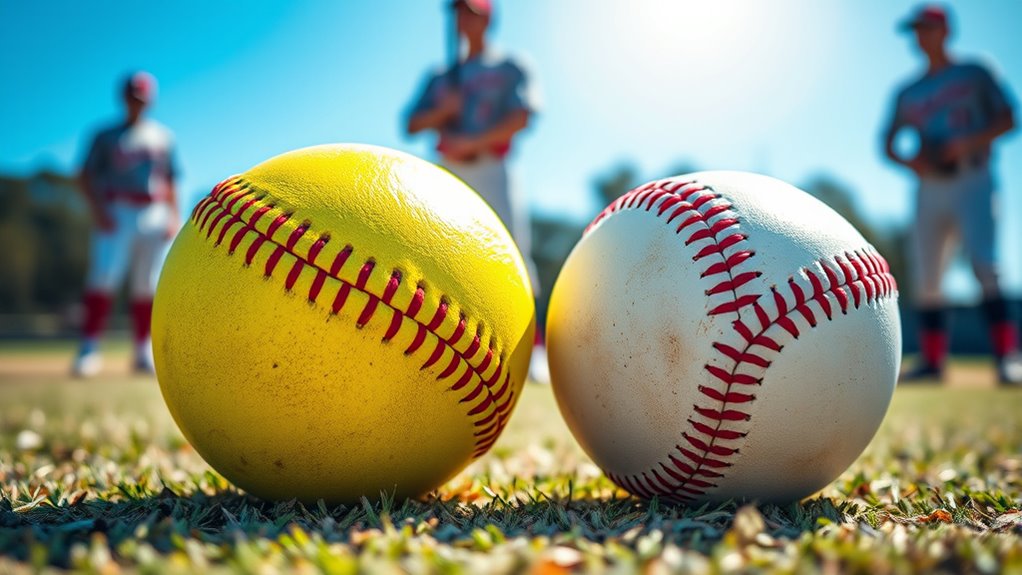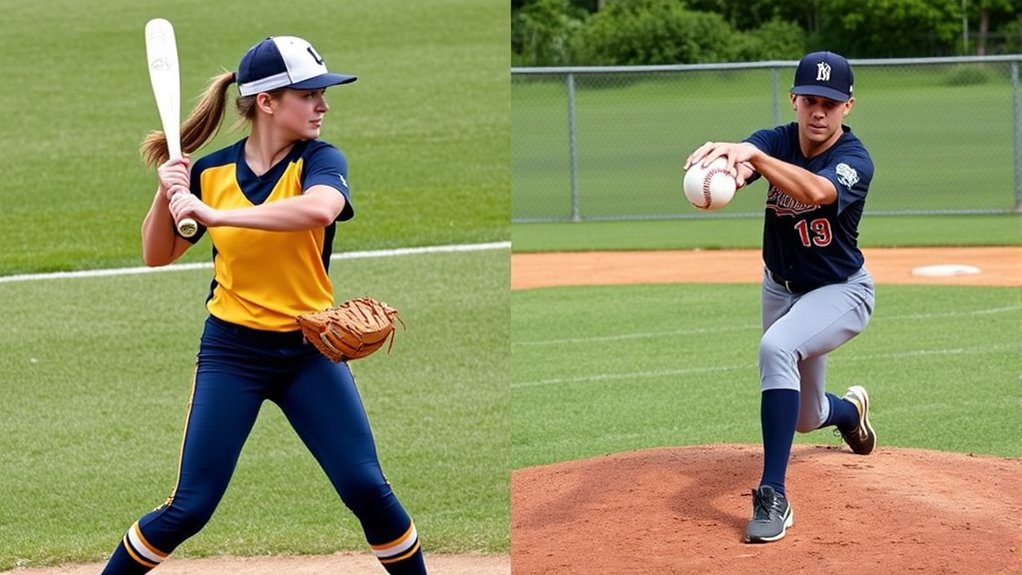Softball and baseball differ mainly in pitching styles, equipment, and game pace. In softball, pitchers throw underhand from a closer distance, focusing on control, while baseball features overhand pitches with higher speeds. The balls are different sizes, and the gloves vary to fit those sizes. The game strategies also change because of base distances and equipment. Exploring these distinctions helps you understand each sport’s unique rhythm and skill set. Keep exploring to uncover more fascinating details.
Key Takeaways
- Softball uses underhand pitching from a closer distance, while baseball features overhand pitching from a farther mound.
- Softballs are larger (12 inches) and slower, emphasizing control, whereas baseballs are smaller, faster, and more powerful.
- Softball gloves are smaller with open webbing, designed for quick transfers; baseball gloves are larger with closed webbing for speed.
- Softball bases are closer together, affecting running strategies, unlike the wider spacing in baseball.
- Bats in softball are shorter and lighter, favoring quick swings, while baseball bats are longer and heavier for power hitting.

Have you ever wondered how softball and baseball differ? If you’re new to either sport, understanding their key distinctions can seem overwhelming at first. One major difference lies in pitching styles. In baseball, pitchers throw overhand or sidearm from a mound that’s 60 feet 6 inches away from home plate. They rely on a variety of pitches like fastballs, curveballs, and sliders to outwit batters. Softball, on the other hand, features underhand pitching from a flat pitching circle just 43 feet from home plate. The underhand motion results in a different rhythm and pace, emphasizing control and deception over speed. The pitching styles directly influence gameplay, with baseball often showcasing more power and velocity, while softball emphasizes finesse and placement. Proper safety equipment is also essential to protect players during intense gameplay in both sports.
Another notable difference is in glove designs. Baseball gloves tend to be larger, with a more substantial pocket to handle the harder thrown ball, which can reach speeds over 90 miles per hour. The gloves are typically around 11 to 12 inches and have a closed webbing to help secure the ball during quick plays. Softball gloves are slightly smaller, usually between 11 and 12 inches as well, but feature a shallower pocket and more open webbing. This design allows for quicker transfers and easier fielding of the softer, larger softball, which is 12 inches in circumference—bigger than a baseball. The glove design adjustments are essential because of the different ball sizes and pitching distances, affecting how players catch, throw, and field.
These equipment differences extend beyond just gloves. The overall gear, such as bats and bases, are tailored to the sport’s specific needs. Baseball bats tend to be longer and heavier, designed for power hitting, while softball bats are shorter and lighter, favoring quick swings. Bases in softball are also closer together, affecting base-running strategies.
Understanding these differences helps you appreciate why the sports, while similar in name and some rules, feel so different when you watch or play them. The distinct pitching styles and glove designs shape the pace, skill sets, and strategies of each game. Whether you’re considering taking up softball or baseball, recognizing these nuances can boost your enjoyment and help you become a more informed player. It’s these details that make each sport unique, offering different challenges and thrills for players of all levels.
Frequently Asked Questions
Which Sport Has Higher Injury Rates for Beginners?
You might wonder which sport has higher injury rates for beginners. Generally, baseball can be riskier due to its faster pitches and heavier balls. To improve injury prevention, always wear proper safety gear like helmets and padding. Focus on learning correct techniques and warming up properly. Staying cautious and using safety gear helps reduce injury risks, making your experience safer and more enjoyable, regardless of the sport you choose.
How Do Equipment Costs Compare Between Softball and Baseball?
When comparing equipment expenses, softball generally offers more gear affordability for beginners. Softball gear tends to be less costly because the equipment, like bats and gloves, is often cheaper and more widely available. Baseball equipment can be pricier, especially for higher-quality gear. If you’re concerned about gear affordability, softball is a smart choice, as it helps keep equipment expenses lower while still enjoying the game.
Are There Significant Differences in Game Strategies?
You’ll notice that game strategies differ mainly due to pitching techniques and field dimensions. In softball, pitchers use underhand throws, focusing on control and deception, while in baseball, overhand pitching emphasizes speed. Field sizes also influence tactics; softball’s smaller field leads to more aggressive plays and quick decision-making, whereas baseball’s larger dimensions require different positioning and base-running strategies, making each game uniquely challenging and exciting.
Which Sport Offers More Accessible Beginner Leagues?
Jumping into a sport can feel like stepping into a new world, but when it comes to accessible beginner leagues, softball often acts like the welcoming neighbor. It tends to be more beginner-friendly and has higher youth participation, making it easier for newcomers to find supportive, inclusive environments. If you’re starting out, softball leagues are usually more flexible and less intimidating, helping you build confidence while enjoying the game.
How Do Scoring Rules Differ in Softball and Baseball?
In softball and baseball, the scoring systems differ mainly in point calculation. You earn a point each time a player safely rounds all bases and reaches home plate. In softball, the game emphasizes quick, high-scoring plays, often leading to more frequent scoring. In baseball, scoring tends to be more strategic with fewer points per game. Understanding these differences helps you follow and enjoy each sport’s unique pace and style.
Conclusion
Just like David faced Goliath, understanding the differences between softball and baseball empowers you to step onto the field with confidence. Whether you’re swinging a bat or catching a pitch, knowing these key distinctions helps you play better and enjoy every moment. So, embrace the challenge, learn the nuances, and remember—every great player started just where you are now. The field is calling, and your journey begins with one swing of understanding.









